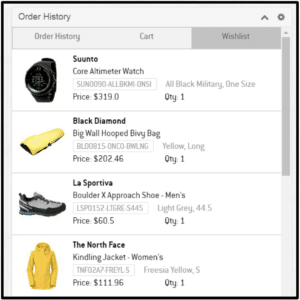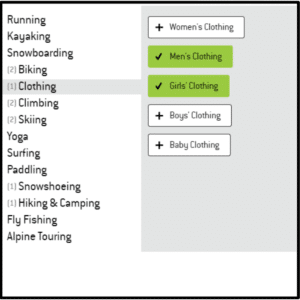Shifting Your Sales Team: From Task-Oriented to Customer-Oriented
No matter the industry you’re in, whether you’re B2C or B2B, operating in an online-driven environment or a traditional brick and mortar store, in the end all businesses share the same goal: you want your sales teams to bring in more revenue.
Typically, sales teams become very focused on completing their task lists quickly and in a way that they can reach as many customers as possible. However, all too many times, customer focus and one-on-one relationship building gets lost in the quest to get as much as possible done, and thus customer satisfaction and customer buying volume drops.
That’s what Backcountry, an elite online retailer specializing in premium outdoor gear and sportswear, realized when they evaluated their strategy for providing customers with more intelligent recommendations and a personalized experience.
Peter Tew, Senior Product Manager at Backcountry, shared some insights with SugarCon attendees this year about how they successfully shifted their sales teams’ thinking and tactics, and thereby realized better customer satisfaction and more revenue opportunities.
Here are 3 tips for transforming your sales team to becoming more customer-centric:
1. Understand Your Unique Business’s Value
No matter the product or service you offer, or how good your technology is, one thing that will always let you differentiate yourself from competitors’ businesses is the quality of service you provide. Your service, as well as relationship- and trust-building that you offer to your customers is unique. In the outdoor retail space, for instance, buying equipment and apparel isn’t an emotionless experience. Customers are looking to connect with a company and sales reps that understand their lifestyle and aspirations. They develop lasting relationships with the companies they deem knowledgeable and authentic. If you are providing an authentic customer experience, no competitor can clone the kind of rapport you build with your customer base. And, in this rather short-lived day and time, the relationship you create with your customers is your biggest value proposition.
So, hone in on your specific industry and leverage the knowledge and passion of your sales reps as they connect with your customers.
2. Know Your Customers
Your sales reps are on the phone with prospects and customers all day long. Every single bit of information you can gather from them (their order history, buying experience, wish list items, preferences, clothing or shoe size, favorite outdoor activities, preferred payment methods, etc.) are gold for your company. And if customer data is gold, treat it as such: collect it meticulously, sort it by shininess, and store it in a cool and dry (and always accessible) place: your goldmine – your CRM.
The key here is how to use all that data you’re gathering about your customers. Storing it in an efficient system is the first step. How you’re organizing and then using it is the next step.
In Sugar, sales reps can adjust their view with customizable dashlets, to specify whether they see a customer’s full order history, their preferred outdoor activities, or even a wish list of products for possible future outings. With Sugar, Backcountry sees all the most important information quickly and in a format that works for each particular business and customer use.


Custom integrations let you review a customer’s purchase history, and the system APIs feed specific data into custom Sugar dashlets, so you can specify what to focus on for a specific conversation.
3. Go From Doing to Doing-What-Matters
While your salespeople are checking off tasks with customers, are they really focusing on the ones that matter the most? What questions are they asking your customers? Are they leading the conversation into a direction that makes customers feel both valued and inclined to jump on their next purchase?
Wouldn’t it be nice if you could structure your sales reps’ activities and calls around those activities that will drive the most sales and retention? How do you do that, you ask? The first step to optimize your sales tactics is to track what your sales team is doing, as well as provide them feedback to what the results of their actions are.
The next step is to refocus and retrain your sales team’s efforts and conversations with customers to the activities that are most impactful.
Depending on your business setup and industry, there are various good touch points for your sales reps to focus on (again, the best way to find that out is to track, give feedback, and align). For Backcountry, some of the things that drove the most success were:
- Recent order placement > follow up on shipment
- Recent review placed > get out a thank you email/call
- Shipment received > follow up to check if size/color/parts are fitting, complete and satisfactory. Also, use that opportunity to ask how the customer plans to use the product.
- 2-4 weeks after product received > check in on how they like and use the product; ask if there’s anything they’re missing/that could be improved.
- For return requests > immediate contact (call/email/chat) and offer a solution to resolve the issue (replacement/send missing parts/better recommendation/different brand product) > the goal is here to save the sale and/or customer loyalty
- 4-6 weeks after product received > reach out to ask the customer to leave a review
- Questions posted online and/or via other channels > immediately address and respond both via direct and public channel (product website, social, etc.)
The key here is to not add to your sales reps’ tasks, but to restructure their tasks and the way they prioritize.
If you implement these three elements into your sales culture, you’ll be able to shift your sales approach from being mostly task-oriented to mostly customer-oriented. For Backcountry, the whole Sugar implementation was as quick as two months.
Watch Backcountry’s whole presentation here:
backcountry.com – Transforming from a Task Oriented to Customer Oriented Sales Culture

